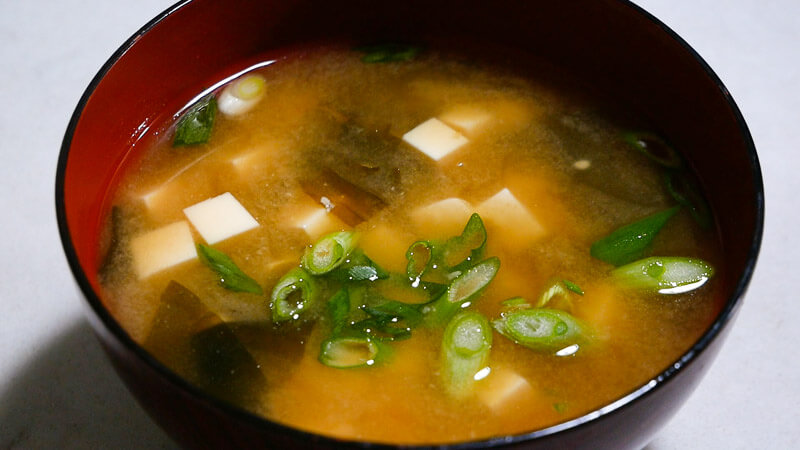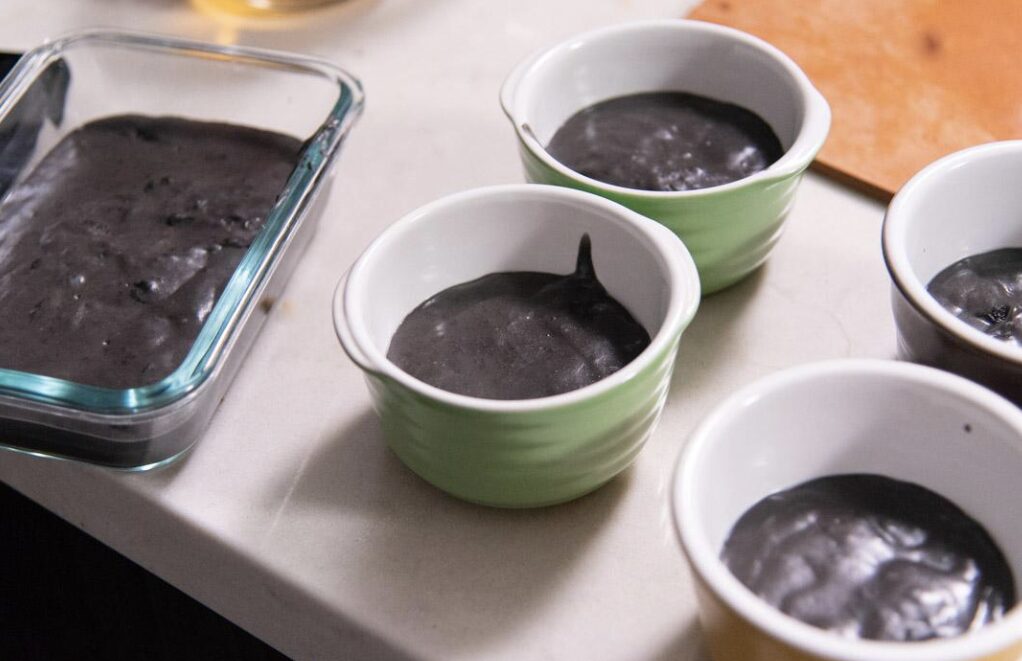Today you are going to learn about miso and an easy recipe for how to make Miso Soup with tofu. There are a few base ingredients that are used, but as far as modifications, the options are endless. Seasonal ingredients are regularly added, however, tofu and wakame (seaweed) are one of the most common. If you’ve never made miso soup before, perhaps now is the time. It’s one of the easiest Japanese soups you can make.
Miso Soup (Misoshiru 味噌汁)

Miso soup is one of my favorite ways to start off a meal.
It’s generally light and packs a ton of flavor.
The soup also smells good and is easy to make.
The only downside is that you need to make this soup in small batches.
Why? Because miso tastes and smells best the day it’s made.
It has many aromatics and probiotics and other nutrients that are good for you.
It does a body good.
And it won’t give you a milk mustache.
Or a miso mustache 🙂 Ha!
How Miso Paste is Made
Miso paste is the main ingredient in miso soup.
The miso paste is usually made from soybeans, grains (usually steamed rice or barley), salt, and koji (麹, Aspergillus Oryzae).
Koji, an Aspergillus Oryzae fungus culture made with grains or beans, is the key to the production of miso. This koji is the same exact mold that is in shio koji, which I used to make my shio koji steak and shio koji asparagus!
After mixing all the soybeans, grains, salt, and koji together, the miso paste is fermented anywhere from six months to five years.
That is a really long time, isn’t it?!
Indeed indeed.
Are you ready to take your miso knowledge to the next level?
Three Principal Categories of Miso
There are three main categories of miso paste. Depending on what steamed ingredient the koji is grown on, you can break out the miso paste into three categories:
- Rice Miso (米味噌󠄀)
- Barley Miso (麦味噌󠄀)
- Made by adding barley koji into soybeans.
- Can be found in Kyushu and Shikoku
- This has a unique flavor and different texture than rice miso
- Soy Miso (豆味噌󠄀)
- Only uses soybeans as ingredients. No rice.
- Can be found in Aichi Prefecture)
- This has a very rich taste that’s just bursting with umami
There are also mixed koji varieties, which are combinations of soy, grain, and koji. Further expanding the variety of miso categories above!
Can it get more complicated? Why yes, it can!
You may have seen various colors of miso.
Well, ever wondered if color meant anything significant?
Turns out it does!
The Color of Miso
The color of miso is affected by many many factors. Here are some examples –
- the type of soybeans
- the type of koji
- whether or not the miso was stirred during fermentation
- the length of fermentation
- during fermentation and maturation process, the Maillard reaction occurs. Simply put, Maillard reactions occur when amino acids and sugars in the miso paste interact with each other resulting in a brownish color. Even after miso becomes a completed product, the maturation process continues, making the color darker.
As you can see there is a lot to consider when making miso. And all these different factors and products mean you can never really get tired of it.
There’s so many different things to try!

Three of the Most Common Types/Colors of Miso paste
If you go to the market or Amazon, chances are you’ll be able to find at least one of the following types of miso paste-
- red miso (reddish-dark brown looking), also known as akamiso (赤みそ)
- This miso is a dark reddish-brown in color. Generally it is more salty and bolder in flavor than white miso.
- white miso (white to very light brown/tan), also known as shiromiso (白みそ)
- This miso is milder than other kinds of miso, with a slight sweetness. It’s the most versatile one for cooking purposes – you can use it for miso soups, miso marinades, and so on.
- mixed miso (brownish), also known as awase miso (合わせ味噌)
- This miso combines two or more different types of miso together. Rather than buy this, you could also just make your own blends! This is one way you’ll never get tired of miso.
Tips for Selecting Your Miso Paste:
If you want…
- organic miso, non-GMO look for these characters (有機, yuuki)
- pure miso without additives, look for these characters (無添加, mutenka)
- miso produced in Japan, look for these characters (国産, kokusan)
- low sodium miso, look for these characters (減塩、genen)
Tips for storing your miso paste-
- Store in the fridge or freezer
- Wrap in plastic wrap tightly to avoid oxidation Some miso comes with a little sheet of wax paper on top!

How to Make Miso Soup with Tofu (Easy Recipe)
Though dashi stock is my favorite base for miso soup, you can also use, chicken, beef, or vegetable broth as your base liquid for miso soup.
Miso paste is always added at the end and never boiled. You’ll boil off all the flavor and aroma otherwise!
Make sure to cut the heat and gradually dissolve the miso paste in the hot broth before you stir it in.
Keep the soup covered if you won’t eat it right away.
As for other ingredients, hard vegetables (those that take long to cook) like daikon radish, kabocha (Japanese pumpkin), potatoes, carrots etc should be cooked before adding to your pot.
You can throw them in the microwave for a bit or just cook in boiling water (before adding powdered dashi, or dashi packs) or if you made your dashi from scratch, in that.
If you don’t cook these vegetables beforehand, you may lose some of the flavor and aroma of your dashi / miso as the vegetables take time to cook.
Softer vegetables like cabbage, onion, moyashi (bean sprouts), spinach, mushrooms, aburaage (fried tofu), tofu, wakame (seaweed), green onions can be added at the very beginning, as you heat the dashi base.




Konnichiwa! (Hello!) I'm Pat Tokuyama, a Japanese tofu cookbook author, who travels for music, food, and adventure. If you like Japanese tea, checkout some of the newestorganic japanese tea, matcha bowls and noren and more!
** Curious about the Plant Based Japanese Cooking Club? ** Learn more here!
A Few More Tips to Consider For Your Next Miso Soup with Tofu
- Use soft or silken tofu, as it has a delicate texture and will hold up well in the soup.
- Cut the tofu into small, bite-sized pieces so it is easy to eat.
- Add the tofu to the soup just before serving, as it can become rubbery if it sits in the hot broth for too long.
- If you want to give the soup a bit of texture, you can lightly pan-fry the tofu before adding it to the soup.
- On the other hand, you can try extra firm or fried tofu cutlet both of which come premade (by house foods)
- If you want to make the soup a bit heartier, you can add a few tablespoons of uncooked rice or quinoa to the pot with the broth.
I hope these tips are helpful! Let me know of your experience making miso soup with a comment below or if you have questions!
Note that miso can be used to make a variety of dishes aside from soup. Here are some of my recipes with miso!
Subscribe to my Youtube channel for easy Japanese cooking videos and more, one new video each Wednesday!







Hi! I’ve just started to make my own home made tofu (and soon tempeh) and I would like to have your opinion about the milk. Is it really better to make it on the pan or it will be just as good in a machine? Thank you so much for your time and for sharing your knowledge. Sónia
hi Sonia! homemade soy milk in a pan or in machine is delicious either way 🙂
how do you usually make it?
I’m impressed with the info. Just starting to learn about making my own miso, so very helpful. TY